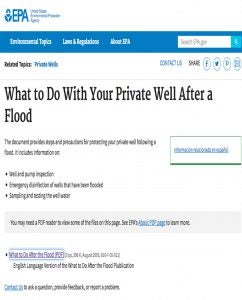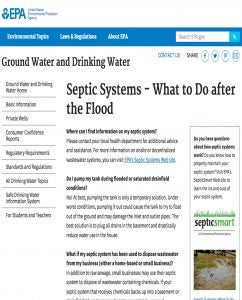Drinking Water and Septic Systems
East Carolina University has accumulated the following resources for dealing with drinking water and septic systems after natural disasters.
Drinking Water Contamination
Natural disasters such as floods, hurricanes and tornadoes are unpredictable. They can happen with little notice. When they strike, however, human lives and properties can be lost or greatly impacted. Survivors often risk their lives from a host of consequences including drinking contaminated water.
Contamination of water sources in the wake of disasters is commonplace. Contamination with a community’s water distribution systems could increase risks of water-borne illnesses such as diarrhea, cholera, and jaundice, among others.
People that rely on private wells for their water supply should take precautions to ensure their water is safe during and after flood conditions. If the flood waters rise above their wellhead, or the well was not properly grouted and sealed and flood waters surrounded the well, then the water supply could be contaminated. One contaminated well could cause water quality problems for an entire neighborhood if all the neighborhood wells were installed the same aquifer.
Water samples from the water supply wells should be collected and analyzed for common pollutants in flood waters such as fecal bacteria prior to using the well water. Most county environmental health departments have personnel that can provide water sampling kits for analyses of the water samples. It is suggested that bottled water and other reserves are used until the results of the testing are known.
Septic Systems
Septic systems may also be affected by flood events. Under normal conditions, wastewater in the septic tank is separated into solids and liquids. The liquid wastewater is piped from the septic tank to drainfield trenches that are installed below the soil surface. Wastewater in the trenches infiltrates through aerated soil and various pollutant treatment mechanisms occur prior to wastewater reaching groundwater.
However, during and after flood conditions the soil is saturated with water. Wastewater leaving the septic tank may rise to the land surface without treatment, because the trenches are filled with floodwater and there is not sufficient capacity to store wastewater. Wastewater contains high concentrations of pathogens that may pollute water and soil. The pathogens may cause people and pets to become ill if they are exposed to the pathogens.
It is recommended that septic system owners limit the use of indoor plumbing during and after flood events to allow their yard and septic drainfield to dry. Wastewater may back up in the home if the soil is too saturated with floodwater. Septic system owners may contact their local environmental health department if problems persist with their septic system. They may also contact certified septic system inspectors to evaluate their system.
Issues related to water quality and sanitation will become more critical for those displaced and living in temporary makeshift shelters. In this situation, infants, children, elderly and sensitive immuno-suppressed sub-populations should be the major focus of the relief efforts as they are typically at higher risks of contracting the disease and can succumb to illness. Below are some informational resources that may be helpful for people that are affected by natural disasters such as hurricanes.









